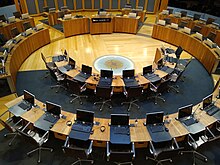
Back Լրացուցիչ անդամի ընտրակարգ Armenian 小選挙区比例代表連用制 Japanese Additional member system NB Sistema de Membro Adicional Portuguese Addeetional Member Seestem SCO Additional Member System SIMPLE ระบบสมาชิกเพิ่มเติม Thai 附帶席位制 Chinese
This article needs additional citations for verification. (May 2015) |
| Part of the Politics series |
| Electoral systems |
|---|
 |
|
|
The additional-member system (AMS) is a mixed electoral system under which most representatives are elected in single-member districts (SMDs), and the other "additional members" are elected to make the seat distribution in the chamber more proportional to the way votes are cast for party lists.[1][2][3] It is distinct from parallel voting (also known as the supplementary member system) in that the "additional member" seats are awarded to parties taking into account seats won in SMDs (referred to as compensation or "top-up"), which is not done under parallel voting (a non-compensatory method).
AMS is categorised under semi-proportional electoral systems, differently from the mixed-member proportional representation (MMP). In practice, the way that proportional additional member systems work depends on the number of additional ("top-up") seats and the votes cast in a specific election.
This article focuses primarily on semi-proportional implementations of AMS, like the ones used in the UK. AMS is used by the Scottish Parliament, the Welsh Parliament and the London Assembly. In Scotland and Wales list members ("top-up" seats) are elected by region; in London there is a single London-wide pooling of list votes.

- ^ "Additional-member system: Politics". Encyclopædia Britannica. Retrieved 24 March 2016.
- ^ "Elections in Wales". Cardiff University. Archived from the original on 30 March 2016. Retrieved 25 March 2016.
- ^ "Electoral Reform and Voting Systems". Politics.co.uk. Archived from the original on 8 April 2020. Retrieved 25 March 2016.
© MMXXIII Rich X Search. We shall prevail. All rights reserved. Rich X Search